Polarization Z-Scan Studies Revealing Plasmon Coupling Enhancement Due to Dimer Formation of Gold Nanoparticles in Nematic Liquid Crystals
Abstract
:1. Introduction
2. Materials and Methods
2.1. Sample Preparation
2.2. Polarization Z-Scan Setup
3. Results and Discussion
4. Conclusions
Author Contributions
Funding
Data Availability Statement
Conflicts of Interest
Appendix A
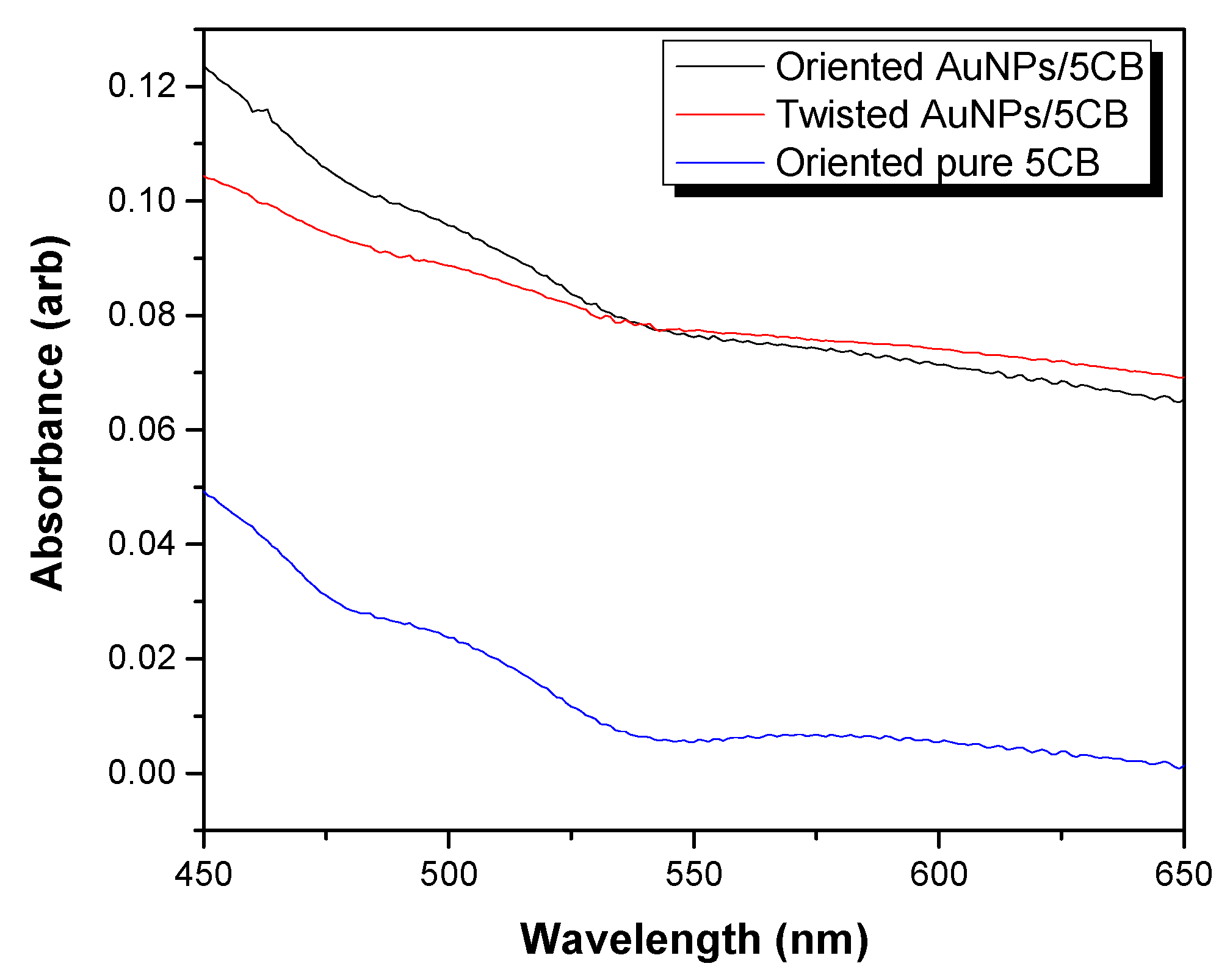
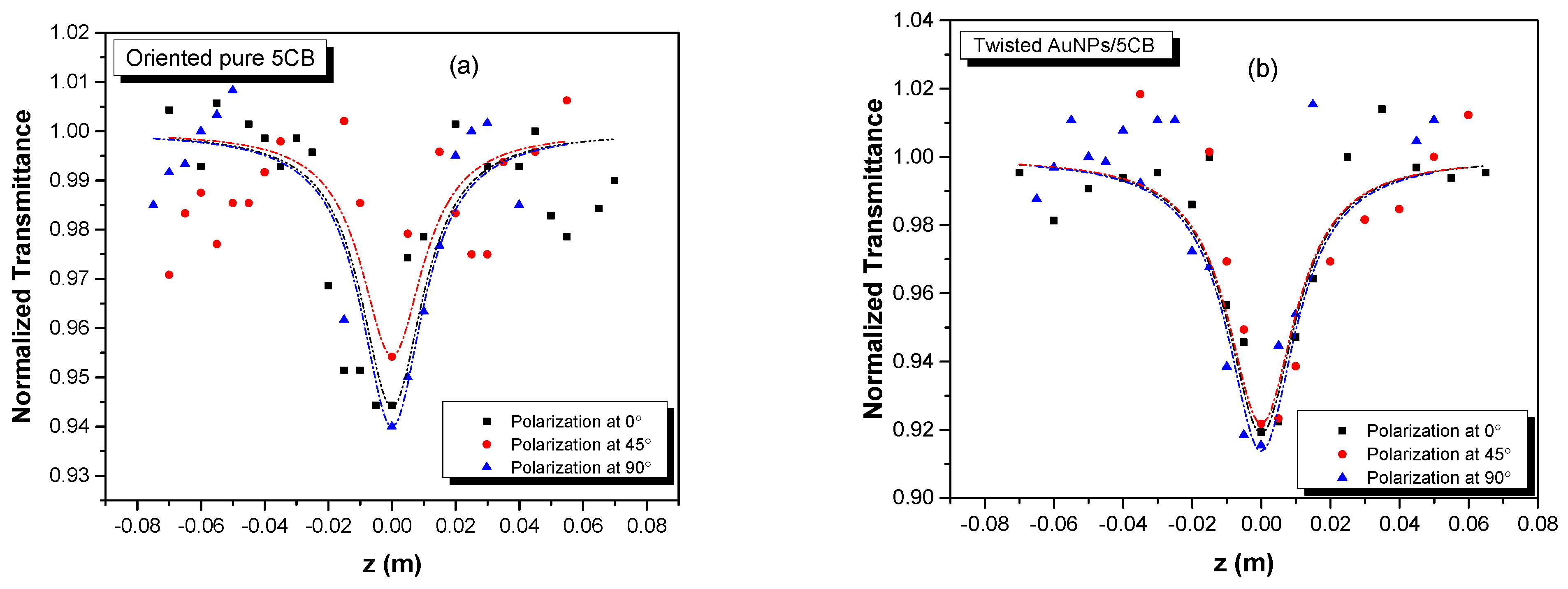

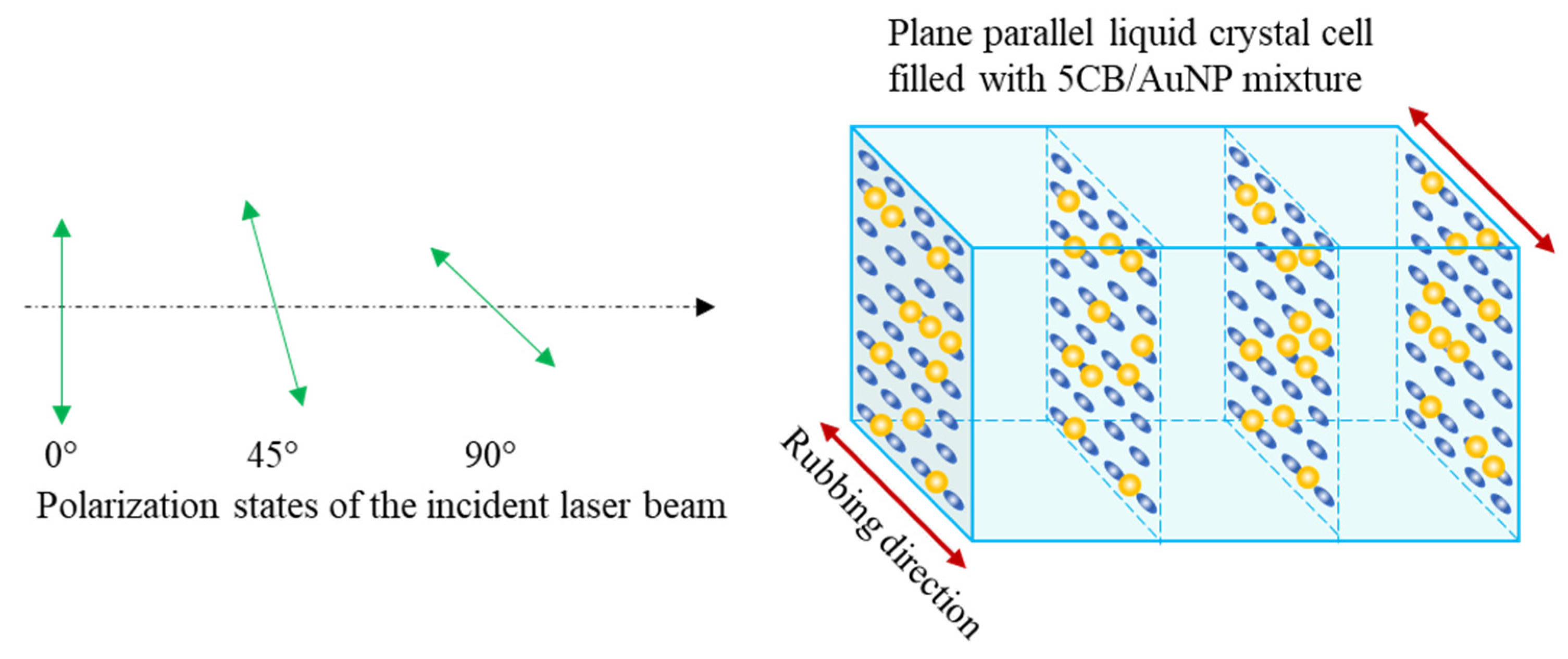
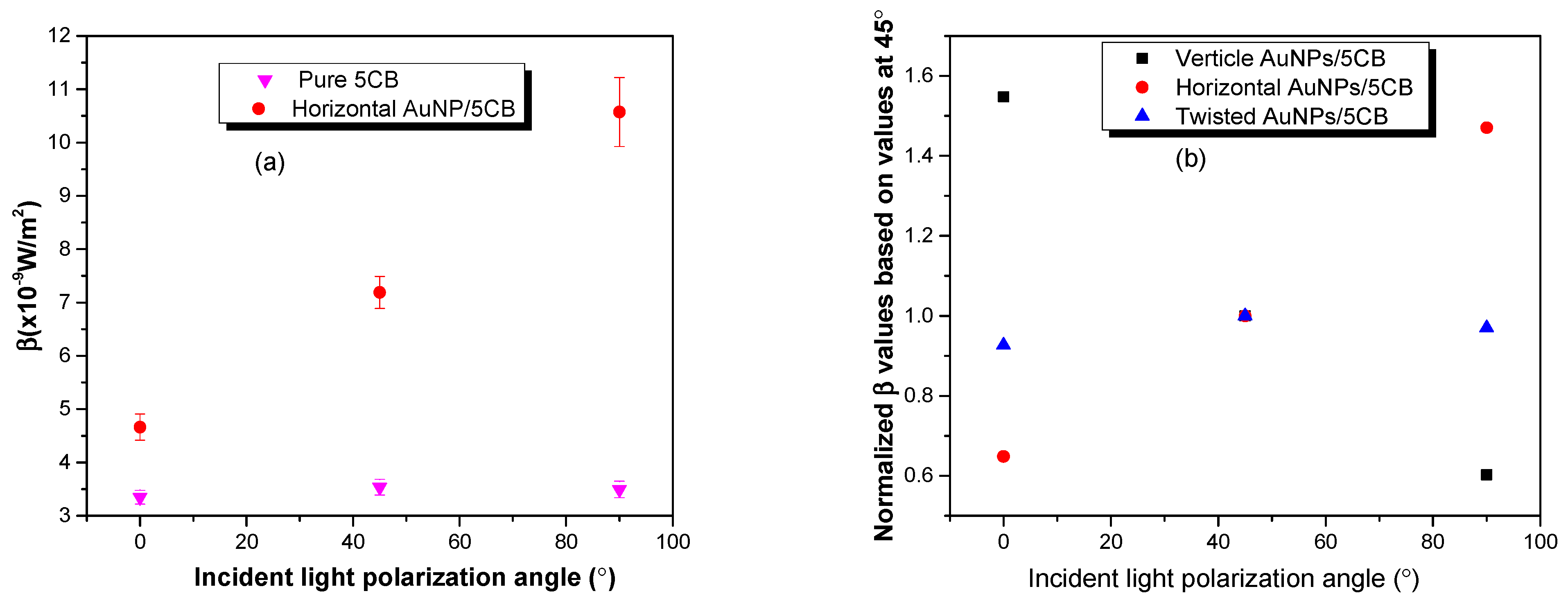
References
- Biswas, S.; Liu, X.; Jarrett, J.W.; Brown, D.; Pustovit, V.; Urbas, A.; Knappenberger, K.L.; Nealey, P.F.; Vaia, R.A. Nonlinear Chiro-Optical Amplification by Plasmonic Nanolens Arrays Formed via Directed Assembly of Gold Nanoparticles. Nano Lett. 2015, 15, 1836–1842. [Google Scholar] [CrossRef] [PubMed]
- Lien, M.B.; Kim, J.Y.; Han, M.G.; Chang, Y.C.; Chang, Y.C.; Ferguson, H.J.; Zhu, Y.; Herzing, A.A.; Schotland, J.C.; Kotov, N.A.; et al. Optical Asymmetry and Nonlinear Light Scattering from Colloidal Gold Nanorods. ACS Nano 2017, 11, 5925–5932. [Google Scholar] [CrossRef] [PubMed]
- Sun, G.; Khurgin, J.B. Origin of Giant Difference between Fluorescence, Resonance, and Nonresonance Raman Scattering Enhancement by Surface Plasmons. Phys. Rev. A 2012, 85, 063410. [Google Scholar] [CrossRef]
- Domingues, R.P.; Rodrigues, M.S.; Proença, M.; Costa, D.; Alves, E.; Barradas, N.P.; Oliveira, F.J.; Silva, R.F.; Borges, J.; Vaz, F. Thin Films Composed of Au Nanoparticles Embedded in AlN: Influence of Metal Concentration and Thermal Annealing on the LSPR Band. Vacuum 2018, 157, 414–421. [Google Scholar] [CrossRef]
- Samsuri, N.D.; Mukhtar, W.M.; Rashid, A.R.A.; Dasuki, K.A.; Yussuf, A.A.R.H.A. Synthesis Methods of Gold Nanoparticles for Localized Surface Plasmon Resonance (LSPR) Sensor Applications. In Proceedings of the EPJ Web of Conferences, Crete, Greece, 17–29 August 2017; EDP Sciences: Les Ulis, France, 2017; Volume 162, p. 01002. [Google Scholar]
- Sepúlveda, B.; Angelomé, P.C.; Lechuga, L.M.; Liz-Marzán, L.M. LSPR-Based Nanobiosensors. Nano Today 2009, 4, 244–251. [Google Scholar] [CrossRef]
- Li, M.X.; Zhao, W.; Qian, G.S.; Feng, Q.M.; Xu, J.J.; Chen, H.Y. Distance Mediated Electrochemiluminescence Enhancement of CdS Thin Films Induced by the Plasmon Coupling of Gold Nanoparticle Dimers. Chem. Commun. 2016, 52, 14230–14233. [Google Scholar] [CrossRef]
- Lee, K.; Irudayaraj, J. Correct Spectral Conversion between Surface-Enhanced Raman and Plasmon Resonance Scattering from Nanoparticle Dimers for Single-Molecule Detection. Small 2013, 9, 1106–1115. [Google Scholar] [CrossRef]
- Sun, G.; Khurgin, J.B.; Bratkovsky, A. Coupled-Mode Theory of Field Enhancement in Complex Metal Nanostructures. Phys. Rev. B 2011, 84, 045415. [Google Scholar] [CrossRef]
- Sun, G.; Khurgin, J.B. Comparative Study of Field Enhancement between Isolated and Coupled Metal Nanoparticles: An Analytical Approach. Appl. Phys. Lett. 2010, 97, 263110. [Google Scholar] [CrossRef]
- Pal, K.; Sajjadifar, S.; Abd Elkodous, M.; Alli, Y.A.; Gomes, F.; Jeevanandam, J.; Thomas, S.; Sigov, A. Soft, Self-Assembly Liquid Crystalline Nanocomposite for Superior Switching. Electron. Mater. Lett. 2019, 15, 84–101. [Google Scholar] [CrossRef]
- Danckwerts, M.; Novotny, L. Optical Frequency Mixing at Coupled Gold Nanoparticles. Phys. Rev. Lett. 2007, 98, 026104. [Google Scholar] [CrossRef] [PubMed]
- Singh, B.P.; Sikarwar, S.; Agarwal, S.; Singh, D.P.; Pandey, K.K.; Manohar, R. Chemically Functionalized Gold Nanosphere-Blended Nematic Liquid Crystals for Photonic Applications. ACS Omega 2023, 8, 2315–2327. [Google Scholar] [CrossRef] [PubMed]
- Maldonado, M.; Baltar, H.; Gomes, A.S.L.; Vaia, R.; Park, K.; Che, J.; Hsiao, M.; de Araújo, C.B.; Baev, A.; Prasad, P.N. Coupled-Plasmon Induced Optical Nonlinearities in Anisotropic Arrays of Gold Nanorod Clusters Supported in a Polymeric Film. J. Appl. Phys. 2017, 121, 143103. [Google Scholar] [CrossRef]
- Maccaferri, N.; Barbillon, G.; Koya, A.N.; Lu, G.; Acuna, G.P.; Garoli, D. Recent Advances in Plasmonic Nanocavities for Single-Molecule Spectroscopy. Nanoscale Adv. 2021, 3, 633–642. [Google Scholar] [CrossRef] [PubMed]
- Chang, Y.; Jiang, Y.; Sun, X. Plasmonic Coupling from Silver Nanoparticle Dimer Array Mediating Surface Plasmon Resonant Enhancement on the Thin Silver Film. Appl. Phys. B 2013, 113, 503–509. [Google Scholar] [CrossRef]
- Pal, K.; Si, A.; El-Sayyad, G.S.; Elkodous, M.A.; Kumar, R.; El-Batal, A.I.; Kralj, S.; Thomas, S. Cutting edge development on graphene derivatives modified by liquid crystal and CdS/TiO2 hybrid matrix: Optoelectronics and biotechnological aspects. Crit. Rev. Solid State Mater. Sci. 2021, 46, 385–449. [Google Scholar] [CrossRef]
- Garti, N.; Somasundaran, P.; Mezzenga, R. Self-Assembled Supramolecular Architectures: Lyotropic Liquid Crystals; John Wiley & Sons: Hoboken, NJ, USA, 2012; ISBN 1118336577. [Google Scholar]
- Mundoor, H.; Wu, J.-S.; Wensink, H.H.; Smalyukh, I.I. Thermally Reconfigurable Monoclinic Nematic Colloidal Fluids. Nature 2021, 590, 268–274. [Google Scholar] [CrossRef]
- Sang, J.; Zhou, X.; Xia, Z.; Sun, J.; Wang, J.; Shang, J.; Zhang, Y.; Zhao, S.; Neyts, K. Dispersion and Tunable Alignment of Colloidal Silver Nanowires in a Nematic Liquid Crystal for Applications in Electric–Optic Devices. ACS Appl. Mater. Interfaces 2023, 15, 11016–11023. [Google Scholar] [CrossRef]
- Fleury, B.; Senyuk, B.; Tasinkevych, M.; Smalyukh, I.I. Interplay of Electrostatic Dipoles and Monopoles with Elastic Interactions in Nematic Liquid Crystal Nanocolloids. Nano Lett. 2020, 20, 7835–7843. [Google Scholar] [CrossRef]
- Zhang, Y.; Liu, Q.; Mundoor, H.; Yuan, Y.; Smalyukh, I.I. Metal Nanoparticle Dispersion, Alignment, and Assembly in Nematic Liquid Crystals for Applications in Switchable Plasmonic Color Filters and E-Polarizers. ACS Nano 2015, 9, 3097–3108. [Google Scholar] [CrossRef]
- Khoo, I.C. Liquid Crystals for Optical Switches, Smart Windows, Reconfigurable/Tunable Meta-Structures, Micro-Resonator Coupling and Plasmonic Nanostructures. Liq. Cryst. XXVII 2023, 12658, 98–110. [Google Scholar]
- Chang, C.-H.; Lin, R.-J.; Tien, C.-L.; Yeh, S.-M. Enhanced Photoluminescence in Gold Nanoparticles Doped Homogeneous Planar Nematic Liquid Crystals. Adv. Cond. Met. Phys. 2018, 2018, 8720169. [Google Scholar] [CrossRef]
- Senyuk, B.; Evans, J.S.; Ackerman, P.J.; Lee, T.; Manna, P.; Vigderman, L.; Zubarev, E.R.; van de Lagemaat, J.; Smalyukh, I.I. Shape-Dependent Oriented Trapping and Scaffolding of Plasmonic Nanoparticles by Topological Defects for Self-Assembly of Colloidal Dimers in Liquid Crystals. Nano Lett. 2012, 12, 955–963. [Google Scholar] [CrossRef] [PubMed]
- Hess, A.J.; Funk, A.J.; Liu, Q.; De La Cruz, J.A.; Sheetah, G.H.; Fleury, B.; Smalyukh, I.I. Plasmonic Metamaterial Gels with Spatially Patterned Orientational Order via 3D Printing. ACS Omega 2019, 4, 20558–20563. [Google Scholar] [CrossRef]
- John, V.N.; Shiju, E.; Arun, R.; Ravi Varma, M.K.; Chandrasekharan, K.; Sandhyarani, N.; Varghese, S. Effect of Ferroelectric Nanoparticles in the Alignment Layer of Twisted Nematic Liquid Crystal Display. Opt. Mater. 2017, 67, 7–13. [Google Scholar] [CrossRef]
- Matt, B.; Pondman, K.M.; Asshoff, S.J.; Haken, B.T.; Fleury, B.; Katsonis, N. Soft Magnets from the Self-Organization of Magnetic Nanoparticles in Twisted Liquid Crystals. Angew. Chem. Int. Ed. 2014, 53, 12446–12450. [Google Scholar] [CrossRef] [PubMed]
- Shivaraja, S.J.; Gupta, R.K.; Kumar, S.; Manjuladevi, V. Enhanced Electro-Optical Response of Nematic Liquid Crystal Doped with Functionalised Silver Nanoparticles in Twisted Nematic Configuration. Liq. Cryst. 2020, 47, 1678–1690. [Google Scholar] [CrossRef]
- Lee, W.; Wang, C.Y.; Shih, Y.C. Effects of Carbon Nanosolids on the Electro-Optical Properties of a Twisted Nematic Liquid-Crystal Host. Appl. Phys. Lett. 2004, 85, 513–515. [Google Scholar] [CrossRef]
- Kim, D.; Ndaya, D.; Bosire, R.; Masese, F.K.; Li, W.; Thompson, S.M.; Kagan, C.R.; Murray, C.B.; Kasi, R.M.; Osuji, C.O. Dynamic Magnetic Field Alignment and Polarized Emission of Semiconductor Nanoplatelets in a Liquid Crystal Polymer. Nat. Commun. 2022, 13, 2507. [Google Scholar] [CrossRef]
- Baik, I.S.; Jeon, S.Y.; Lee, S.H.; Park, K.A.; Jeong, S.H.; An, K.H.; Lee, Y.H. Electrical-Field Effect on Carbon Nanotubes in a Twisted Nematic Liquid Crystal Cell. Appl. Phys. Lett. 2005, 87, 263110. [Google Scholar] [CrossRef]
- Wang, S.; Fu, C.; Sun, G.; Gharbi, M.A.; Yelleswarapu, C.S. Plasmon Enhancement of Third-Order Nonlinear Optical Absorption of Gold Nanoparticles Dispersed in Planar Oriented Nematic Liquid Crystals. Nanotechnology 2023, 34, 365205. [Google Scholar] [CrossRef] [PubMed]
- Lamprecht, B.; Schider, G.; Lechner, R.T.; Ditlbacher, H.; Krenn, J.R.; Leitner, A.; Aussenegg, F.R. Metal Nanoparticle Gratings: Influence of Dipolar Particle Interaction on the Plasmon Resonance. Phys. Rev. Lett. 2000, 84, 4721. [Google Scholar] [CrossRef] [PubMed]
- Markowicz, P.P.; Samoc, M.; Cerne, J.; Prasad, P.N.; Pucci, A.; Ruggeri, G. Modified Z-Scan Techniques for Investigations of Nonlinear Chiroptical Effects. Opt. Express 2004, 12, 5209–5214. [Google Scholar] [CrossRef] [PubMed]
- Mohan, D.; Dhar, R. Polarization-Dependent Z-Scan Characterization for Optical Nonlinearity in Pyran Dye. Laser Phys. 2013, 23, 125401. [Google Scholar]
- He, G.S.; Cho, M.J.; Kim, W.J.; Baev, A.; Urbas, A.; Prasad, P.N. Polarimetric Z-Scan Study of Nonlinear Chirooptic Properties of Chiral Polyfluorene. Adv. Opt. Mater. 2013, 1, 763–767. [Google Scholar] [CrossRef]
- Zhang, Q.; Wu, X.; Han, J. The Influence of Laser-Induced Alignment on Z-Scan Properties of 2D Carbon Nanomaterials Suspension Dependent on Polarization. Sci. Rep. 2022, 12, 10127. [Google Scholar] [CrossRef] [PubMed]
- Liang, J.; Zhao, H.; Zhou, X.; Wang, H. Polarization-Dependent Effects of Refractive Index Change Associated with Photoisomerization Investigated with Z-Scan Technique. J. Appl. Phys. 2007, 101, 013106. [Google Scholar] [CrossRef]
- Bundulis, A.; Mihailovs, I.; Rutkis, M. Origin of the Kerr Effect: Investigation of Solutions by Polarization-Dependent Z-Scan. JOSA B 2020, 37, 1806–1811. [Google Scholar] [CrossRef]
- Melhado, M.S.; de Souza, T.G.B.; Zilio, S.C.; Barbano, E.C.; Misoguti, L. Discrimination between Two Distinct Nonlinear Effects by Polarization-Resolved Z-Scan Measurements. Opt. Express 2020, 28, 3352–3360. [Google Scholar] [CrossRef]
- Sheik-Bahae, M.; Said, A.A.; Wei, T.-H.; Hagan, D.J.; Van Stryland, E.W. Sensitive Measurement of Optical Nonlinearities Using a Single Beam. IEEE J. Quantum Electron. 1990, 26, 760–769. [Google Scholar] [CrossRef]
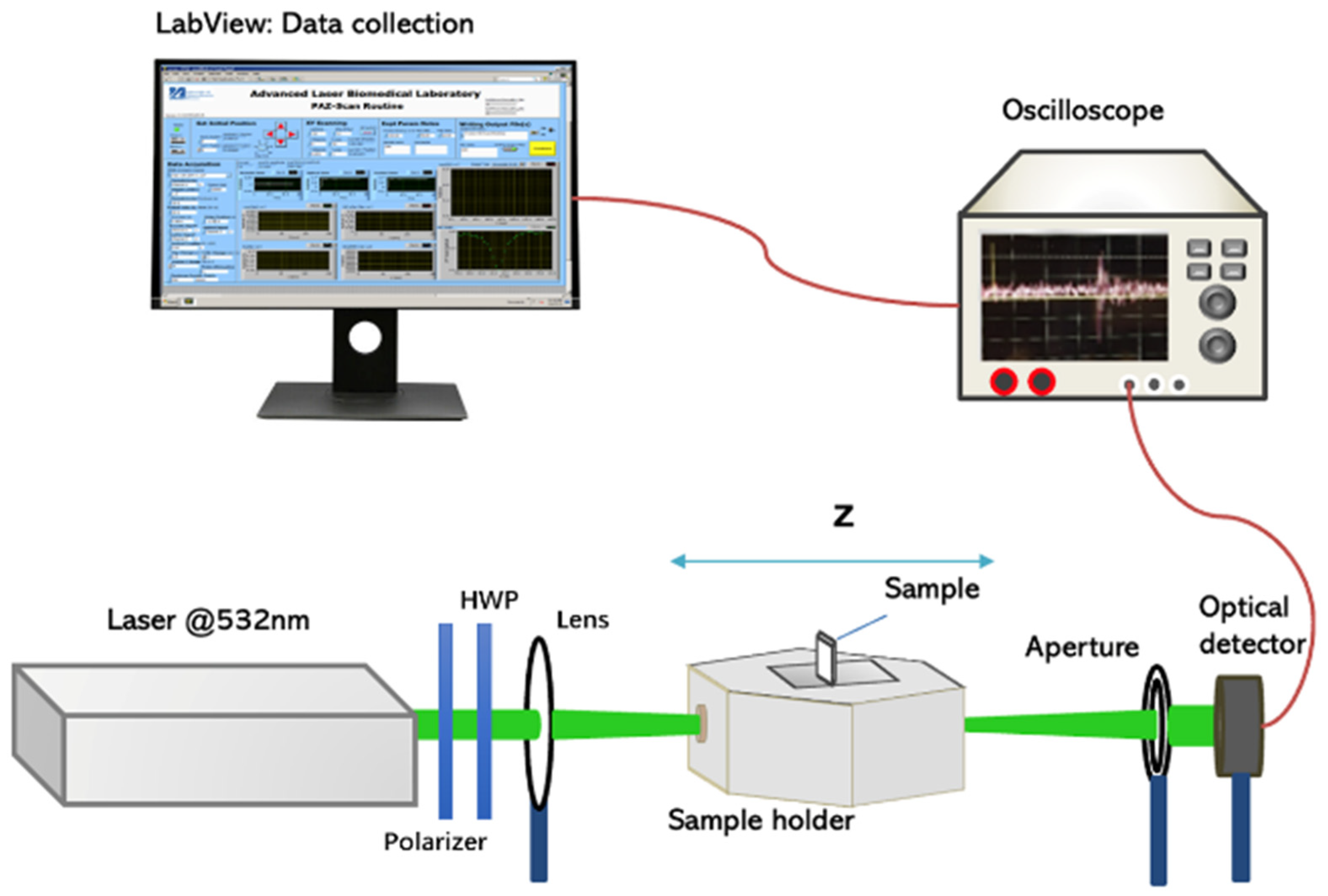

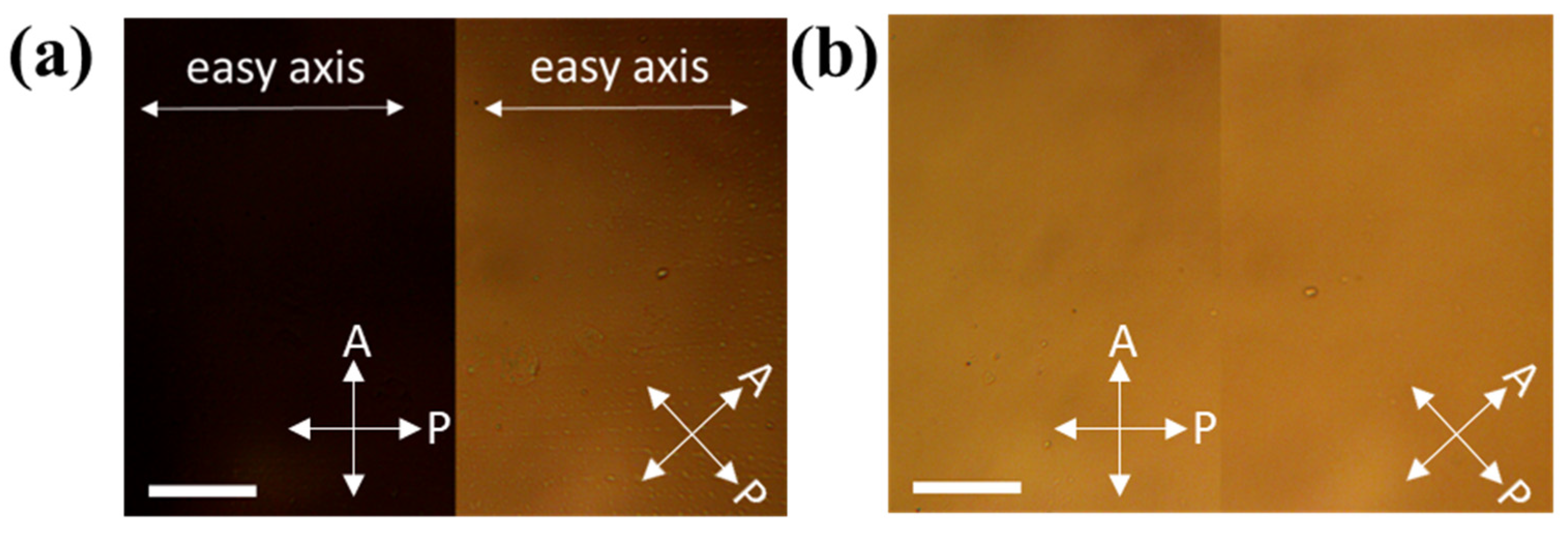




Disclaimer/Publisher’s Note: The statements, opinions and data contained in all publications are solely those of the individual author(s) and contributor(s) and not of MDPI and/or the editor(s). MDPI and/or the editor(s) disclaim responsibility for any injury to people or property resulting from any ideas, methods, instructions or products referred to in the content. |
© 2023 by the authors. Licensee MDPI, Basel, Switzerland. This article is an open access article distributed under the terms and conditions of the Creative Commons Attribution (CC BY) license (https://creativecommons.org/licenses/by/4.0/).
Share and Cite
Wang, S.; Lipchus, E.J.; Gharbi, M.A.; Yelleswarapu, C.S. Polarization Z-Scan Studies Revealing Plasmon Coupling Enhancement Due to Dimer Formation of Gold Nanoparticles in Nematic Liquid Crystals. Micromachines 2023, 14, 2206. https://doi.org/10.3390/mi14122206
Wang S, Lipchus EJ, Gharbi MA, Yelleswarapu CS. Polarization Z-Scan Studies Revealing Plasmon Coupling Enhancement Due to Dimer Formation of Gold Nanoparticles in Nematic Liquid Crystals. Micromachines. 2023; 14(12):2206. https://doi.org/10.3390/mi14122206
Chicago/Turabian StyleWang, Shengwei, Edward J. Lipchus, Mohamed Amine Gharbi, and Chandra S. Yelleswarapu. 2023. "Polarization Z-Scan Studies Revealing Plasmon Coupling Enhancement Due to Dimer Formation of Gold Nanoparticles in Nematic Liquid Crystals" Micromachines 14, no. 12: 2206. https://doi.org/10.3390/mi14122206
APA StyleWang, S., Lipchus, E. J., Gharbi, M. A., & Yelleswarapu, C. S. (2023). Polarization Z-Scan Studies Revealing Plasmon Coupling Enhancement Due to Dimer Formation of Gold Nanoparticles in Nematic Liquid Crystals. Micromachines, 14(12), 2206. https://doi.org/10.3390/mi14122206






